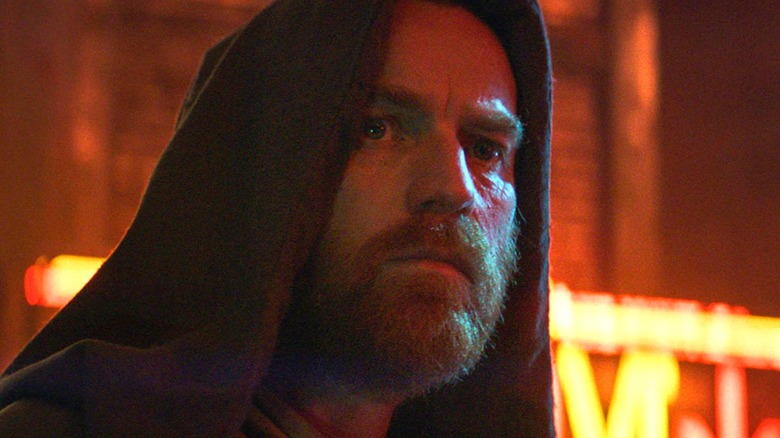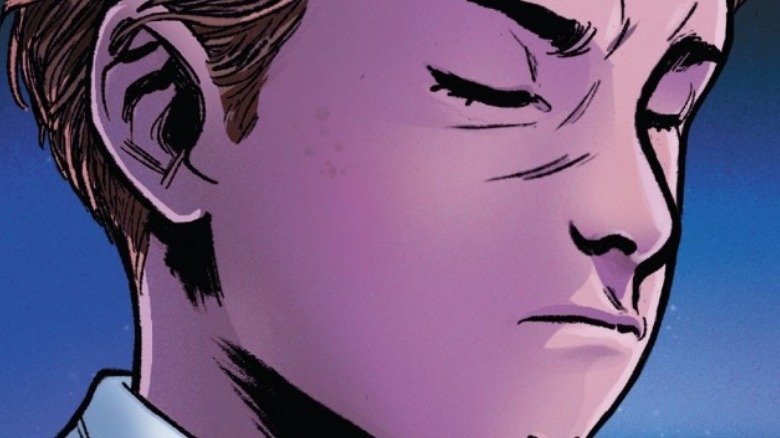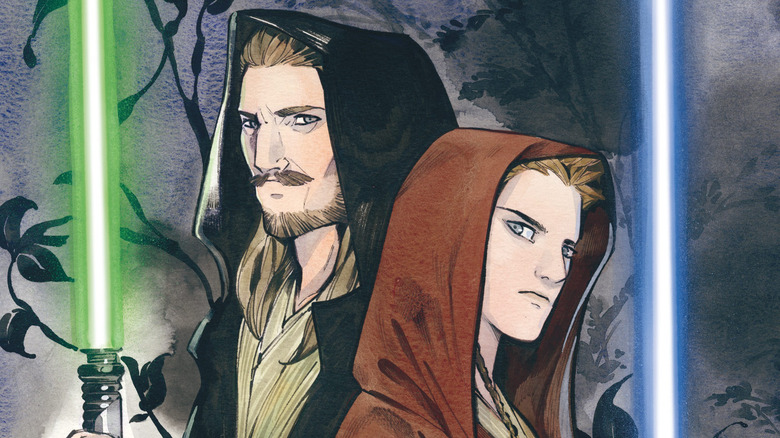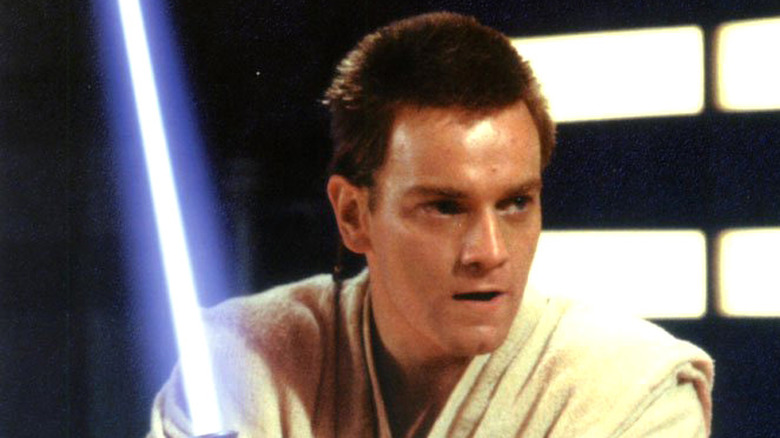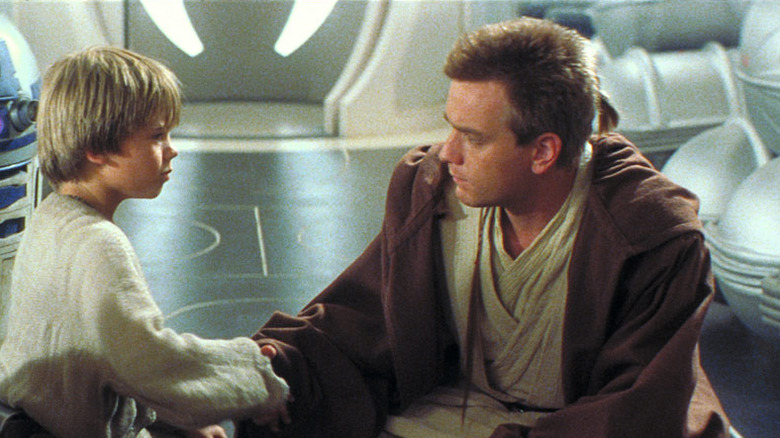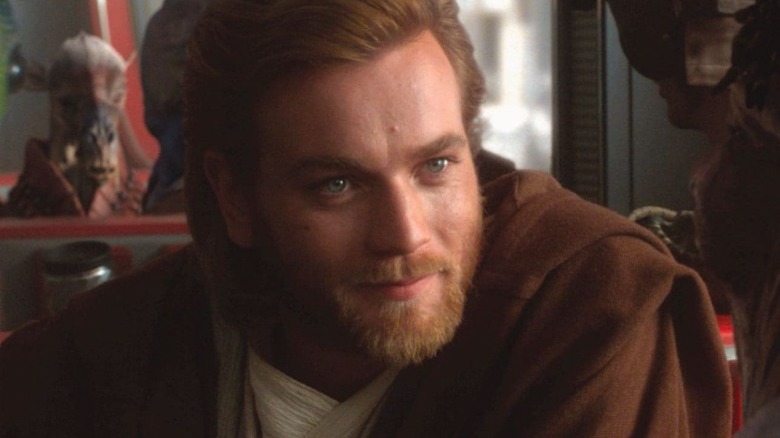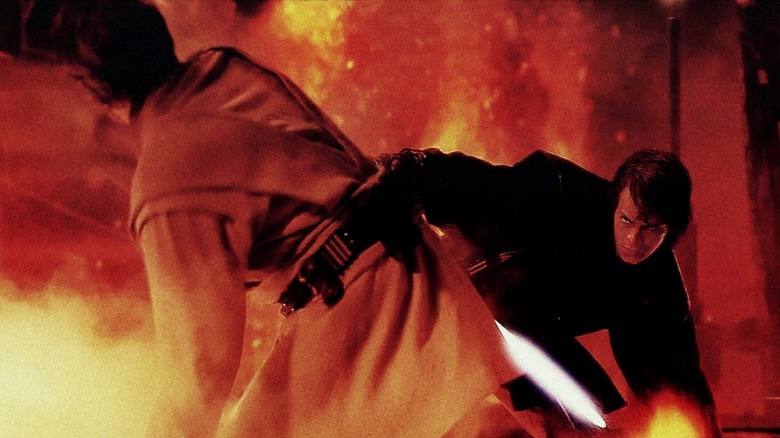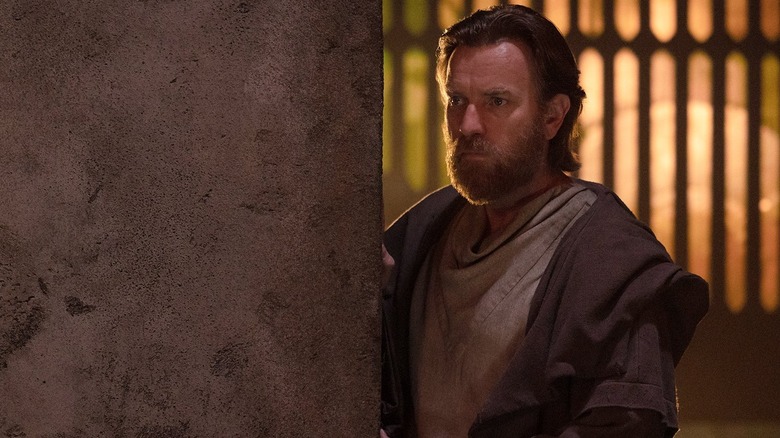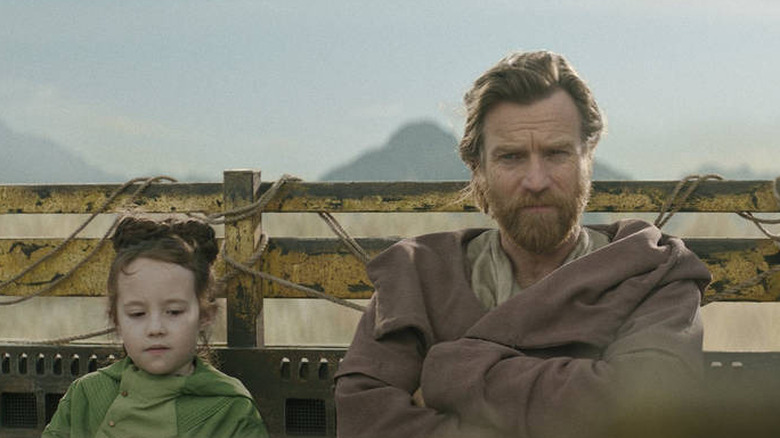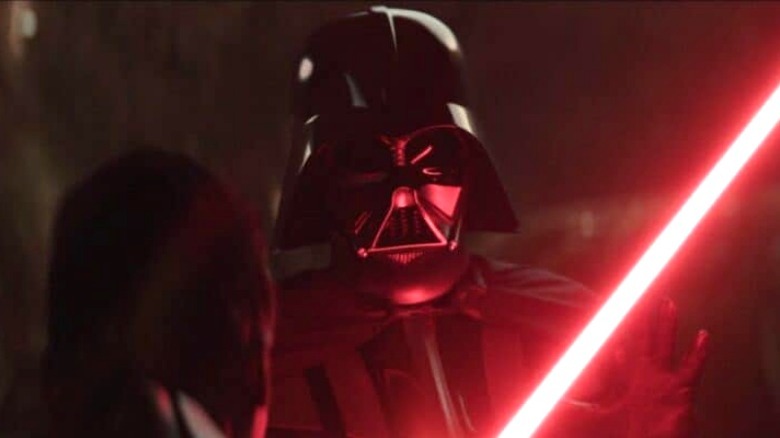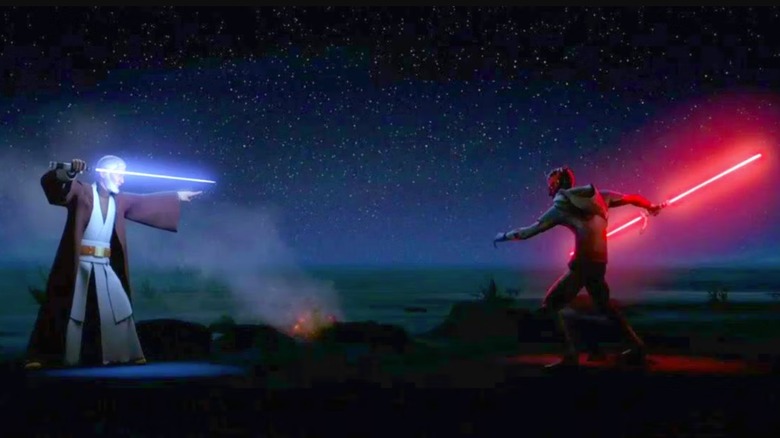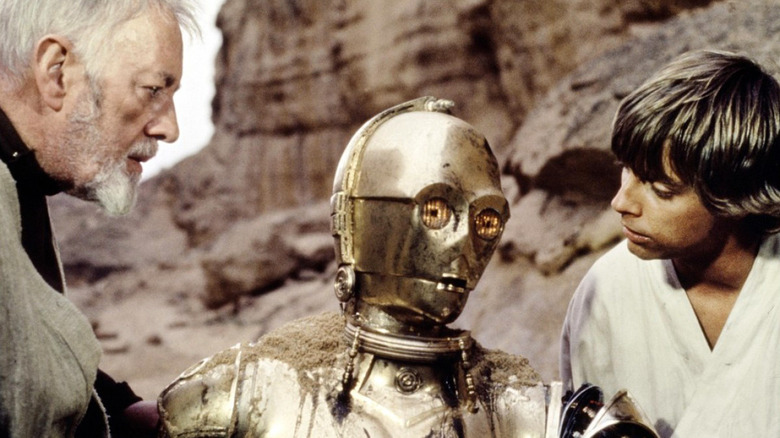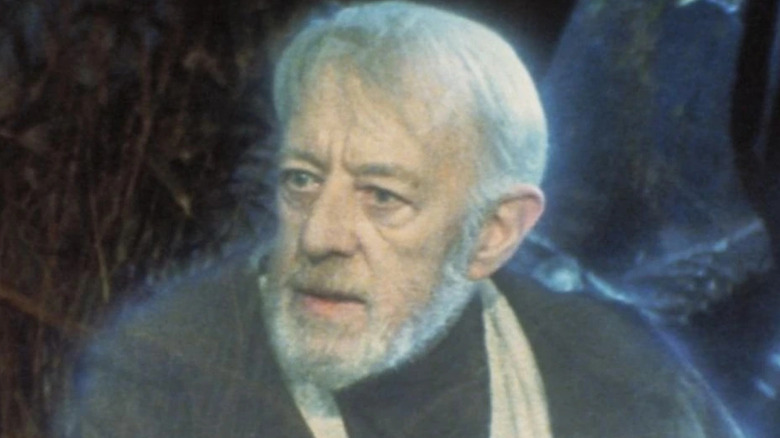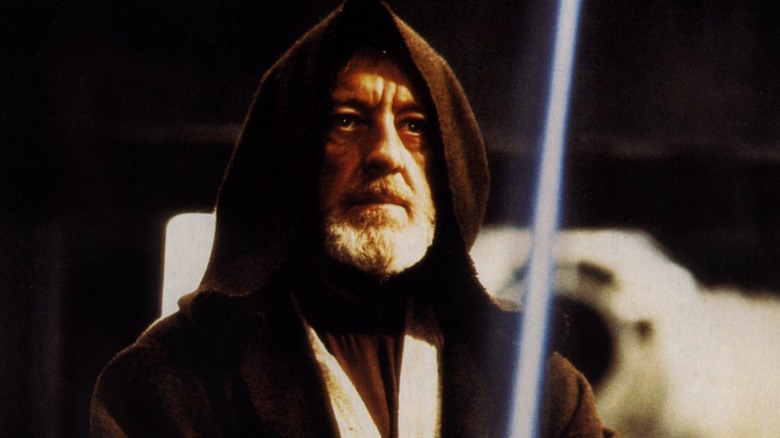Obi-Wan Kenobi's Entire Timeline, Explained
"Kenobi," the "Revenge of the Sith" novelization says, "was luminous, a transparent being, a window onto a sunlit meadow of the Force" — and if any Jedi actually was a window on a sunlit meadow of the Force, it was old Ben for sure. However, the first true Jedi that the Star Wars fandom ever met did not attain this status easily, nor without tremendous effort and suffering. As his backstory has developed over nearly five decades, Obi-Wan has become one of the most revered and three-dimensional characters in the entire Star Wars canon.
Now, thanks to the Disney+ series "Obi-Wan Kenobi," we know that the Jedi Master's years in exile were far more action-packed than we originally thought — and that, unlike the rest of the Star Wars franchise, he actually managed to leave Tatooine for a time. This is Obi-Wan's story laid out in full, from his time as a youngling in the Jedi Temple to his stint on Tatooine to his death — and beyond.
A note for newcomers: The Star Wars timeline is based around the events of "Star Wars: Episode IV — A New Hope." "BBY" stands for "Before the Battle of Yavin," which is where Luke Skywalker destroyed the first Death Star. Accordingly, "ABY" means "After the Battle of Yavin," or everything that happens past the end of that movie.
Born — 57 BBY
Yes, this is canon: Obi-Wan Kenobi, one of the greatest Jedi Knights of the Republic Age, is from the planet ... Stewjon. Yes, like Jon Stewart, the talk show host. Star Wars, everybody!
Like other Force-sensitive children, Obi-Wan was, with the consent of his parents, taken to the Jedi Temple Creche when he was six months old. In "Obi-Wan Kenobi," our man tells Princess Leia that he thinks he might have had a brother. That's a nod to the 1983 novelization of "Return of the Jedi," in which Owen Lars was revealed to be Obi-Wan's sibling. "Attack of the Clones" retconned this to make Owen Anakin's step-brother, but either way, it's always nice to have family in the desert.
Obi-Wan's year of birth has appeared in some reference books, including "Jedi vs. Sith: The Essential Guide to the Force," as well as a collectible in "Star Wars: Card Trader." In general, that checks out. Alec Guinness, who played Original Formula Obi-Wan, was 62 years old when "Star Wars" was shot, so the actor and the character were about the same age in "A New Hope." It's generally accepted that Obi-Wan's birth year remained constant in the prequel films, and that his intense grief over Anakin Skywalker's betrayal, plus the heat from Tatooine's two suns, aged him enough to explain the dramatic change in his appearance between the end of "Obi-Wan Kenobi" and the beginning of "A New Hope."
Temple life and youngling years — 56 BBY-41 BBY
Along with other tiny Jedi Initiates, Obi-Wan was raised in the Jedi Temple on Coruscant as part of an "Initiate Clan"; this was his new family. Obi-Wan's was called the Kybuck Clan, and he quickly became popular amongst his creche mates. This period, known as Initiate training, laid the foundation of his path as a Jedi, and ended when he was promoted to Padawan.
Rebellious from a young age, Obi-Wan spent most of his time learning under Yoda and the other Masters. During this time, Obi-Wan learned about how the Force worked, as well as the roots of Jedi traditions and the importance of meditation. He received age-appropriate schooling about major tenants of Jedi philosophy, and trained in combat and lightsaber forms.
Most of what we know about life as a child in the Temple is gleaned from the seven seasons of "The Clone Wars." If we apply what was shown of Ahsoka's experience to Obi-Wan's upbringing, we can surmise that he probably helped to herd Initiates and smaller younglings when he, too, became a Padawan.
Padawan adventures — approximately 41 BBY-32 BBY
As an Initiate, Obi-Wan built his first battle-ready lightsaber in a ritual called "The Gathering," during which he and the rest of his clan went to the Crystal Caves on the snowy planet Ilum. As part of this adventure, Obi-Wan set off on a Force-guided quest to seek out the kyber crystal that would power his first lightsaber, a challenge that forced him to face his most prominent faults and failings. A similar journey is illustrated in the fifth season of "The Clone Wars" episode "The Gathering," in which Ahsoka and Yoda lead a clan of initiates to Ilum.
In his teenage years, Obi-Wan became an apprentice to Jedi Master Qui-Gon Jinn. The partnership was initiated by Yoda, who saw that the two would grow into a formidable mentor-mentee pair. Equal parts fond of and frustrated with one another, Obi-Wan was the more strait-laced of the two, while Qui-Gon was more rebellious, particularly through his explorations of the Living Force. This relationship was further fleshed out in the novel "Master and Apprentice," which featured Obi-Wan as an older teenager, and adds more details about Qui-Gon's relationship with future Sith Lord Count Dooku, to whom he was apprenticed. In several ways, Obi-Wan's exasperation with and love for Qui-Gon prepared him for his tumultuous relationship with his own future Padawan, Anakin Skywalker.
The Phantom Menace and knighting — 32 BBY
"The Phantom Menace" gives us our best look at Obi-Wan's time as a Padawan, and shows us how he met nine-year-old Anakin Skywalker and took part in the best lightsaber battle in Star Wars history (or, at the very least, the one with the best John Williams score).
Obi-Wan's raw potential, his power, and his faults are on display here; Obi-Wan was a spectacularly talented warrior and a valiant Jedi, but was just beginning to understand the true depths of the Force, and didn't fully appreciate the value of each sentient being. When Obi-Wan and Qui-Gon met the Sith Lord Darth Maul in battle, only Obi-Wan survived — and even then, he wasn't really victorious. As "The Clone Wars" creator Dave Filoni asserts, although Obi-Wan won the battle against Darth Maul, the dark side won the war.
After Qui-Gon was killed in the three-way duel, he was no longer able to train Anakin, and dutiful Obi-Wan took up the task. Filoni believes that if Qui-Gon, not Kenobi, had taught Anakin, the boy would have grown up with the father he needed, instead of the brother he did not. However, the Force works in mysterious ways, and maybe even Qui-Gon would admit that Obi-Wan's devotion to mercy and patience prepared the way for Darth Vader's eventual redemption.
While Obi-Wan was granted full Jedi Knighthood at the end of the film, he related in a story in "From a Certain Point of View" that Anakin's late entry into the Jedi Order, and the socialization and training that he missed, were a cause of great anxiety. The freshly-minted Jedi Knight worried more about his treatment of a nine-year-old boy than losing his own life to a terrifying Sith Lord.
Attack of the Clones and the Clone Wars — 31-BBY-19 BBY
The seven seasons of "The Clone Wars" fill in the gaps between "Attack of the Clones" and "Revenge of the Sith," chronicling Obi-Wan's adventures with Anakin and his own Padawan, Ahsoka. On the surface, this consisted mainly of Obi-Wan twirling his lightsaber and yelling at Anakin, and then Anakin doing something impetuous and yelling at Ahsoka, and then everybody laughing and slaughtering some robots.
However, as far as Obi-Wan's character development was concerned, there was much more happening under the surface. In "Attack of the Clones," Obi-Wan was sent on a quest that led to the discovery of the Republic's clone army and conveniently knocked him out of the way as the romance between Anakin and Padme — and Anakin's journey towards the Dark Side — advanced. This Obi-Wan was near the apex of his considerable prowess. However, his humility had also grown, as shown when he asks Yoda for advice about his mission.
In "The Clone Wars," Obi-Wan is depicted as a wise and solicitous general who valued each clone as an individual human. He also began to treat Anakin as more of an equal. Some of the show's arcs revealed Obi-Wan's teenage infatuation with the Mandalorian Duchess Satine Kryze, who he and Qui-Gon protected while on the run for nearly a year. Obi-Wan admitted that he would have left the Jedi Order had she asked, underlining a fundamental difference between Kenobi and Anakin: While Anakin attempted to have it all — a marriage and the life of a Jedi — Obi-Wan understood the dangerous nature of over-attachment, why Knights were forbidden to marry, and the temptations that such relationships presented to a Jedi.
In an attempt to hurt Obi-Wan, a resurrected Darth Maul killed Satine in front of him. But Obi-Wan remained steadfast in his dedication to the light — and, as a Jedi attuned to others' virtuousness, probably assumed that his former Padawan possessed the same commitment.
Anakin becomes Vader — 19 BBY
Anakin, traumatized by the loss of his mother and Qui-Gon and his arrival to the Jedi Temple about eight years too late, never worked past his anger or his desire to control the fates of those he cared for. Dishonest, compromised, and led astray, Anakin turned to the dark side in "Revenge of the Sith," operating under the impression that he could cheat death on behalf of his secret wife. Obi-Wan tracked his former pupil down in an attempt to either save him or kill him.
This led to the scene that was alluded to in the original "Star Wars," imagined in "Empire," and hinted at in the novelization of "Return of the Jedi": The moment when Obi-Wan Kenobi and his former Padawan engaged in a titanic lightsaber battle on the volcanic planet Mustafar. The aftermath left Anakin near death, and his rage powered his final transformation into Darth Vader. Taken in both physically and mentally by Emperor Palpatine, Anakin, in Obi-Wan's words, became "more machine now than man, twisted and evil."
Padme, who was carrying Anakin's twins, died despite his efforts. The babies were saved, though, and Obi-Wan was the first living being to hold infant Luke Skywalker. Obi-Wan took Luke to Anakin's step-brother on desolate Tatooine, and stayed there to watch over him, while Leia was sent to the five-star planet of Alderaan to become the foster daughter of Bail and Breha Organa.
The Emperor's Order 66, which forced the Clone Troopers to all but wipe out the Jedi, drove remaining Force users into hiding. However, in some ways, Obi-Wan's service was just beginning.
Obi-Wan in exile — 19 BBY-9 BBY
In his last act as a member of the Jedi Order, Obi-Wan subverted a plot to draw any surviving Jedi back to Coruscant, replacing it with a message warning them to lie low, trust in the Force, and await a more promising hour.
"Obi-Wan Kenobi" begins midway through Obi-Wan's subsequent exile. Throughout this period, Obi-Wan kept a watchful eye on Luke. Imperial Inquisitors, who show up a great deal in the animated series "Rebels," hunted for Kenobi on Vader's behalf, and "Obi-Wan Kenobi" suggests that he let his considerable skills lapse in order to avoid drawing attention to himself. Obi-Wan took up a nametag job, attempted to establish contact with Qui-Gon through the Force, and buried his lightsaber beside Anakin's in the sands of Tatooine.
But even though he was taking care of Luke from afar, it turned out that Leia needed him even more.
Obi-Wan rescues Leia Organa — 9 BBY
No, we're not at "A New Hope" quite yet. This was the other time that Obi-Wan rescued Leia, when Leia was kidnapped by a Sith Inquisitor to draw Kenobi out of hiding. After expressing deep concern about Luke, Obi-Wan responded to the call of his old friend Bail Organa, who needed help tracking down his foster daughter. The early rematch with Vader that followed revealed Obi-Wan's tremendous rustiness and lack of peace with himself.
The "Obi-Wan Kenobi" miniseries changes the import of Leia's holographic message in a "New Hope" and Obi-Wan's role in Luke Skywalker's hero's journey; it also transformed his character from an honorable, dignified warrior who never lost hope to an utterly broken man who'd needed an adventure with a sassy little girl to reignite his lost faith. Up to this point, Obi-Wan was unwavering, patient, and always attuned to the Force. This was a new side of the Jedi; perhaps other comics, novels, or TV series will reconcile the difference, but then again, there always were more layers to Obi-Wan than he let on.
However canon changed thanks to "Obi-Wan Kenobi," the series' real draw was another rematch with Vader before the two met on the Death Star in "A New Hope." On that front, the show delivered.
Obi-Wan and Vader's rematch — 9 BBY
While Ben Kenobi made errors that even an aging and out-of-practice Obi-Wan would not, Kenobi and Vader's second rematch was a studied symphony of all Obi-Wan had learned during his life as an active Jedi Knight and during his exile.
Obi-Wan besting Vader established him as the superior Jedi — and yet, he still wasn't the one destined to redeem Anakin. Kenobi defeated Vader with tactical skill and his refusal to give in to revenge, just as Anakin's son would 10 years later in the Emperor's throne room during the climax of "Return of the Jedi."
By showing mercy after once again defeating his former pupil, Obi-Wan conquered this evil creature in a way that death never could — it's easy to imagine Vader replaying this moment in his mind as he watched the Emperor attempt to kill his unarmed son. Still every inch a gallant Jedi, Obi-Wan's compassion allowed for the possibility of Anakin's redemption, even though from this point onward Obi-Wan thought of his friend as dead. Thankfully, the Jedi was comforted in the interim by the long-awaited reappearance of his original Master, Qui-Gon Jinn.
Desert Adventures — 9-0 ABY
Season 2 of "Obi-Wan Kenobi" has been the source of many rumors, but it's going to have some previously established canon to dodge first. The era between "Obi-Wan Kenobi" and "A New Hope" has been largely explored in comics, which tell tales about Kenobi defending Luke and the Lars family from various threats, including Boba Fett and Black Krrsantan, the extremely non-Chewbacca-like Wookiee who played a supporting role in "The Book of Boba Fett."
The most emotionally resonant moment of this era took place in "Rebels," just before the events of the original "Star Wars." Obi-Wan was tracked down by Darth Maul, still furious that he could not best Kenobi by murdering those he cared about. Obi-Wan killed Maul once more for old time's sake, but burnished the purity of his character even while doing so; the old Jedi Master was a gentleman about the whole event. Despite the immense pain that Maul caused him over the years, Obi-Wan provided comfort and kindness to the Sith Lord as he died, pitying his dark state.
As Obi-Wan attempted to connect with Maul, he once again looked past the grief the Sith had purposely inflicted, and found flickers of the light that the Zabrak never had the opportunity to nurture. Here on Earth, this is called saintly behavior; for Obi-Wan, it's simply how a Jedi operated, even in the worst of times — especially in the worst of times.
Although emotionally entangled with Darth Maul, Kenobi's relationship with another Sith Lord was even more multifaceted. This last moment of training for Obi-Wan prepared him to fight against Darth Vader one final time.
The Battle of Yavin — 0 BBY
This is the core of the entire franchise: The events of "A New Hope." This is when moviegoers met Obi-Wan Kenobi for the first time, and when he was little more than a weird old wizard with a massive drop-off on his resume.
Obi-Wan's original job description was to function as Luke's old, wise, soon-to-be-dead mentor as the young man embarked his hero's journey. George Lucas wavered on whether to keep Obi-Wan around until the end of the film. However, wisely bowing to mythical traditions (and Sir Alec Guinness' suggestion), the guide was killed off midway through the adventure. In its original context, this final duel with Vader was a plot device that helped Luke Skywalker mature, but the massive expansion of Obi-Wan's backstory that has followed continues to alter this meeting's emotional meaning.
Due to the technical limitations of 1977, this is by far the slowest, least pyrotechnic lightsaber battle in the franchise. However, its emotional resonance is second only to Vader and Luke's last throwdown in "Return of the Jedi." With the weight of almost 50 years of history behind it, this final fight is the one that sees Obi-Wan's long-held prophecy fulfilled: Anakin would be the death of him, but not at all his end.
Retirement into Force ghostdom — 0 BBY-34 ABY
We've already established that Obi-Wan's teaching style consisted of yelling at Anakin for being an idiot. Well, following "A New Hope," Obi-Wan also yelled at Luke, albeit in Force ghost form. While Luke only hears Obi-Wan's voice at the end of "A New Hope," the Jedi Master's full form appears in "The Empire Strikes Back" and "Return of the Jedi." The "Star Wars" version of the afterlife borrows much from the Catholic tradition of holy apparitions, and Obi-Wan's guiding presence shows character growth even beyond his heroic end in "A New Hope."
In the original trilogy, Obi-Wan was Lucas' Scotch tape for plot holes, and helped provide definitive answers for lingering mysteries. Was Darth Vader really Luke's father? Well ... from a certain point of view, sure. There, all fixed.
However, "Obi-Wan Kenobi" emphasized that this "view" came from Vader himself, who claimed that he "killed" Anakin during their climactic duel. Still, it's unclear why Kenobi would agree, even if he was attempting to protect Luke from a horrific truth. The followers of the dark side are not generally known for telling the truth, and this retcon sits uneasily with many fans.
The sequel trilogy — 34-35 ABY
Just when both Ewan McGregor and Alec Guinness thought they were free of Lucasfilm, they got pulled right back in again by the sequel trilogy. In "The Force Awakens," Obi-Wan spoke to Rey when she found the lightsaber used by both Anakin and Luke: "Rey, these are your first steps." Clips of both McGregor's and Guinness' voices were used to create the effect, and fans immediately wondered what was going on with the lightsaber, as well as Obi-Wan's connection to it. Many fan theories posited that Rey was in fact a Kenobi, possibly the offspring of Obi-Wan and Satine, or maybe a clone.
But Obi-Wan then vanished until the final moments of "The Rise of Skywalker." As Rey lay defeated at Palpatine's hands, all of the Jedi who passed into the Force slid into her DMs for a pep talk. Obi-Wan contributed, "These are your final steps, Rey. Rise and take them. Rey ... rise." Then, understandably, he left again, probably to yell at Luke some more. As of this writing, this is the final appearance of Obi-Wan in the Star Wars timeline.
With the new comic series "Star Wars: Obi Wan" providing a more detailed look at Obi-Wan's youngling years and another season of "Obi-Wan Kenobi" possibly on the way, there's still more to learn about the Jedi Master. As our favorite "window onto a sunlit meadow of the Force," he's not only helping Luke, Leia, or Anakin reach their full potential. Obi-Wan's grace in battle, in life, and in death is an example all of us can learn from, and it is an honor to be one of his Padawans.
